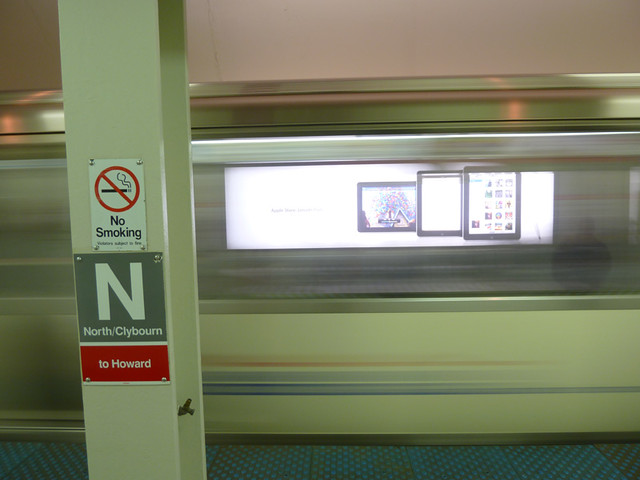

 |
|

NOTE: Speaking of pizza, as this post will shortly, check out my color commentary and, more to the point, Dan Zemans’ definitive bestiary of Chicago pizza styles in this Serious Eats piece.
Almost is the saddest word in a food writer’s lexicon. Of course, most often it’s saddest in the sense of “We almost like your idea enough to pay you to write it for us.” But it can also be in the sense of, a place that almost pulls it off, almost gets what it takes to go from okay to really good, but misses. Herewith, two recent examples.
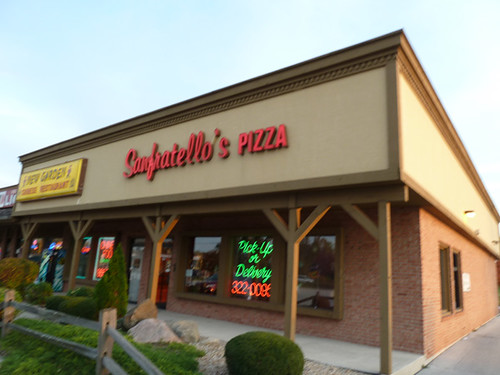
Sanfratello’s
I first spotted Sanfratello’s a zillion years ago on, I think, the way south side ice cream tour on LTHForum. (Sadly, the photos aren’t linked any more.) The original Sanfratello’s is down in Glenwood, wherever that is, somewhere around Tinley Park or somewhere. And under Mike G’s rules, as a pizza place that’s been around since the 1960s, it deserved to be tried. But it’s also sprouted a half dozen other locations all on the Indiana side of the southeast side/Northwest Indiana region, in places like Highland, so when I took the boys over there for an event a while back, we spotted a Sanfratello’s and tried it for dinner. (Actually we spotted one and went in, turned out it was takeout only, so they told us how to find another a couple of miles away.)
In many ways it’s a typical Chicago thin crust, except for one eccentricity— which turns out to be of huge importance. Basically, this is fried pizza. Yes, fried. You heard it right.
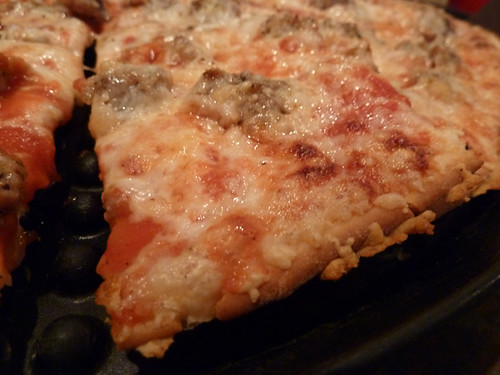
It’s not as weird as it sounds. Basically it means you put the dough in a metal pan which has been very liberally greased, and the grease liquefies enough and fries it enough to crisp up the outside. It’s actually done with a lot of pan pizzas, producing a characteristic moonscape texture on the bottom where bubbles form, and so on. (Pizza Hut’s pan pizza is something of an example.)
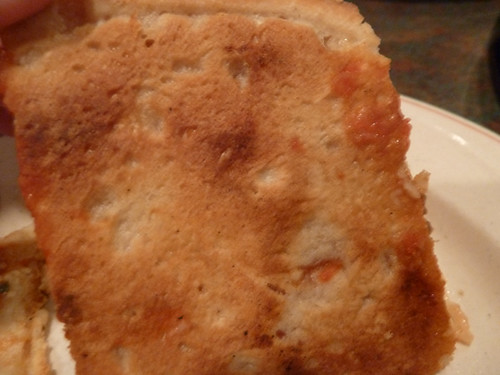
But on a pan pizza, it helps fluff up the fast-rising, bready-spongey crust. Here, on a short dough, it hardens it like a popover, and fries the edges of the cheese that spill over. It’s a very different sensation, there’s something essentially un-pizza-like about this cookie-like crust and the caramelized grilled cheese edges, something that seems halfway to being pastry.
But I’d have liked it as an oddball outlier among south side thin crusts, except for one thing— well, two things: the toppings and the sauce just didn’t have that much flavor. Give me a tasty tomato sauce, even a sweet one like Aurelio’s (another south side chain), and give me Italian sausage with some real fennel-y kick and porky funk to it, and I could have loved it. Unfortunately, I felt both these things were kind of bland. They really did taste like a pizza place from the 1960s, and in a sense that’s no compliment.
Still, I almost liked this weird pizza enough to hunt it down again any time I’m in some farflung place on the southeast side. Almost.
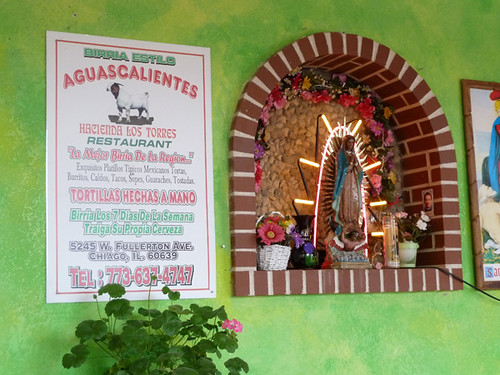
Hacienda Los Torres
Is there a cuisine that breaks your heart by getting wrong what would be so easy to get right, more often than Mexican?
I spotted the word Birria on the sign for Hacienda Los Torres on the west side, and decided to give it a try. There were a lot of signs (literally in some cases) of potential greatness— pork on a pastor spit, this poster proudly advertising their birria, the promise of handmade tortillas. Maybe too many things for them to be good at all of them.
It was also dead at noon. Not a promising sign in this big a place. But I ordered a plate of birria, and a pastor taco on the side.
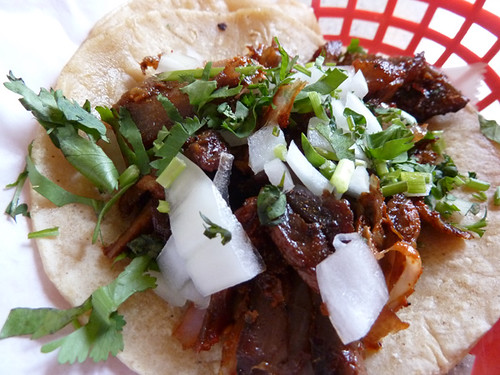
Sadly, I could see that they were flubbing the potential of the pastor taco the moment the cook went to make it. He could easily have flipped on the gyros-spit and made me a beautiful crisped-up taco; but instead he gathered up some meat that had been cut some time earlier from the greasy tray at the bottom of the spit, and put it into a pan to reheat it. Not surprisingly, the result was pastor jerky, pastor Hubba Bubba, and given the time that it had probably spent unrefrigerated… well, I know the rules at LTHForum are that you can’t know who gave you an upset stomach the next day with a definitiveness that would pass legal muster, but let’s just say that that pastor cone would be a key person of interest in the investigation.
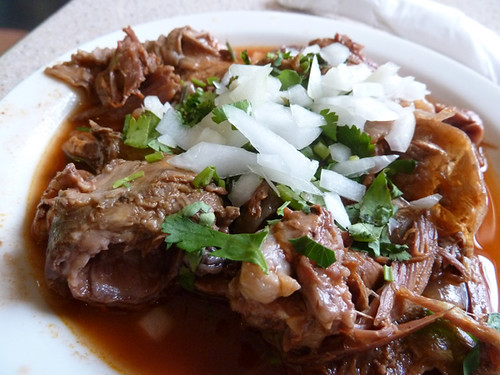
The birria wasn’t much better. Okay, it was probably quite a bit better, without being good. The flavor was all right, but nothing great. But even for a gristly bony meat, this was a seriously fatty, cartilagenous plate of goat. I basically got one, maybe two tacos out of it for about $9; the rest was scrap. I never understand the attitude that insists on dishing up a lousy plate in an empty house— you’ve got one customer for the whole lunch period, and you give him something as bad as this? Shouldn’t you figure that a lot of it’s going in the trash at the end of the day anyway, you might as well dish your only customer up the best plate you can make?
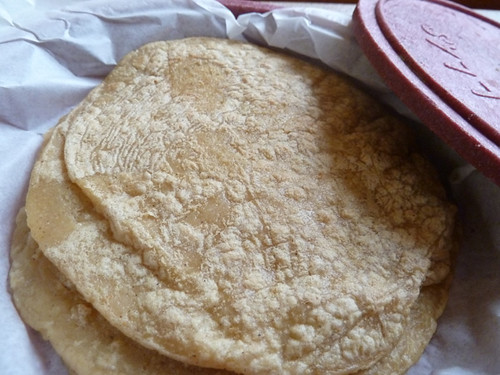
It’s too bad because there were two things that came as part of the meal that were actually quite good. One was the handmade tortillas; though rewarmed, they were still freshly supple and heartily enjoyable. The other was the consomme de chivo (goat soup) that came with the birria:
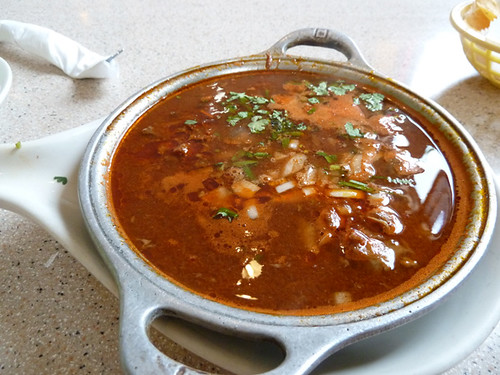
Surprisingly, this had all the complexity and depth of flavor that the birria was lacking— and frankly, it had hardly any less usable meat than the woeful plate of birria, either. This was the only thing I might conceivably return to Hacienda Los Torres for. But as I was leaving the empty restaurant, I saw the cook was taking raw arrachera (skirt steak) and putting it on the grill, to cook it up ahead of time so that it would have the dry, greasy texture of reheated meat whenever a crowd actually came in to order tacos. A pity, almost— but one that suggests habits of convenience over excellence so ingrained there’s no hope of overcoming them.
Hacienda Los Torres
5245 W Fullerton Ave
Chicago, IL 60639
* * *
But to end on a happier, Mexican-flavored note, I went back to Chantico last week with my family, and it continued to be what it was, which is to say, a restaurant that has some impressively flavorful and well-made dishes (a special of caldo de res) and some that seem a little too blandly Ameri-Mex (the fish tacos, mole poblano that’s too chocolatey); but even the less authentic ones are always well prepared with good quality ingredients. And just as pleasing, they are extremely friendly and welcoming, and thanked me for returning by bringing us out a complimentary dessert. No almost about that.

So you’re Ruxbin and you’re riding the wave of good initial reviews, and seeing hour waits for a table between 6:30 and 8:30 on weeknights. But you need to work up a new menu for fall. So you… close down one of the hottest restaurants in town for a week.
Most people in the restaurant biz would call that crazy— would call it leaving money on the table, the way Grant Achatz apparently tried to get Michael Carlson to understand how much money he was leaving on the table by not having a wine program at Schwa. But Carlson is so focused on the food that he just couldn’t listen to that, and neither, apparently, can Edward Kim, the chef and co-owner (with his sister and another Korean friend named Kim) of this tiny, funky little restaurant on Ashland just north of Chicago Avenue. And it’s the kind of craziness that deserves cherishing, and championing.
Ruxbin is not another Schwa— it’s a more down-to-earth neighborhood restaurant, with dishes that sound like fairly plain American bistro food, with a touch of Asian fusion. With its thrift-shop look (like some Korean-American cross between Avec and Chicago Kalbi, with a little Amtrak sleeper coach thrown in), it looks more like the kind of place you’d find in a college town than in money-flashing 2010 Chicago. But besides the similarities to Schwa of being tiny, hard to get into and BYO on Ashland, you get the sense of a comparable degree of intensity, focus, and something like perfectionism in the food. According to Sula in the Reader, Kim “externed at [Thomas Keller’s] Per Se,” whatever that means; I think it means we don’t really know where he learned to cook, but we know who he admires, Mr. Obsessively Clear Broth himself. And as much as I have trouble with cooking totally Keller’s way myself, I’m fine when someone else feels they have to.
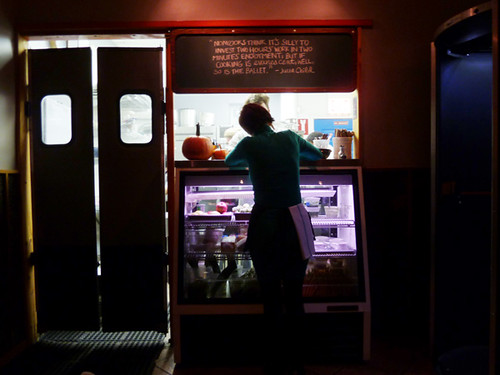
This was my second attempt to go to Ruxbin, and I’d learned from the first to be there by 6:30 at the latest, and to expect a wait. Ironic that in a restaurant decorated with book pages, it’s far too dark to read while waiting, but on the plus side, you get a front-row seat on the kitchen, which is Hong Kong-dense with cooks at work, yet surprisingly peaceful and purposeful, like everyone says Alinea’s is. That lack of the customary testosteronish bustle in the kitchen was perhaps the first clue that this place was professional beyond its years (or location, or budget).
Kim’s deftness with simple ingredients presented simply showed through in the first thing we had, a marvelous salad of sort of tempura-like eggplant slices, cucumber, golden beets and a yogurt sauce. The eggplant had a curious, nobody-can-eat-just-one texture (perhaps partly dehydrated before frying?), the yogurt sauce tasted of simple, honest dairy and herbs, the cucumber (milled into cylinders) and the surprising triangles of beets and the frisee made for new textural sensations with every bite.

Of our three appetizers, that was by far the best; calamari in a Korean chili sauce called bokkum was good, but would have been better still if the sauce had had more funk to it; it seemed like something I would have had at Ed’s Potsticker House, where it would have been half as much, twice as big and three times as funky. While an obligatory nod to the Korean taco-truck thing, an allegedly Korean empanada, was the one real dud of the meal; I might like these fine in a bar, they were fried nicely enough, but the pink goo inside had no particular character of note. If it was meant to be pureed kimchi, it was an argument for allowing kimchi to keep its original texture.
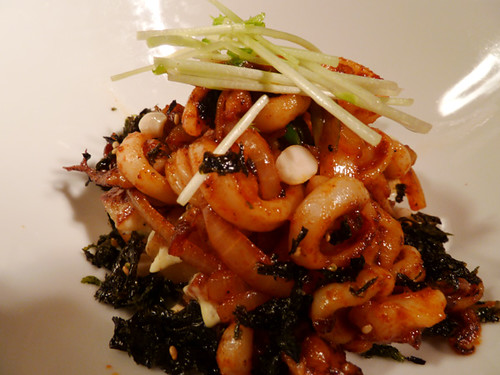
One great and one pretty good out of three is not that great a score, and I suspected that the appetizers would prove to be the highlights next to the almost defiantly plain sounding entrees, since they almost always are these days. But again, the most drab-sounding entree proved to be the most remarkable. I very much enjoyed the more inventive take on chicken and waffles, the most playful or deconstructionist item on the menu, which used a cumin-flavored waffle, slices of white meat chicken, “chicken carnitas” (a fancy, if presumptuous, name for pulled dark meat) and a “citrus gravy” (which didn’t add much). The only downside was that it was the kind of dish that takes so long to assemble that it wasn’t all that warm by the time it got to us.
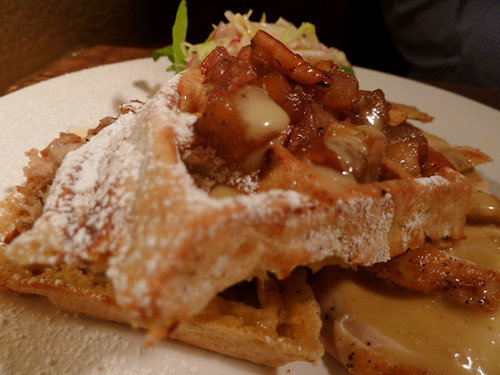
But in any case, it was bowled over by the trout, crisped to a slight char, sitting on surprisingly flavorful and robust bulgur wheat (cooked in something darkly wonderful), surrounded by basil sauce and topped with a few spears of asparagus and a couple of candied dates. It looks like hotel banquet food, but everything about it was just executed so well, was so full of rich, cold-weather flavor (yes, I know asparagus and basil are not fall produce, but the overall dish was autumnal just the same), that it was almost breathtakingly satisfying— comfort food at its most stimulatingly alert and intriguing.

We finished with one of the only two desserts, coconut-lychee panna cotta, and it was a perfect end, Asian-light yet bright and happy. I would have this dessert with every meal for the next six months.

So it’s a bit of a stealth restaurant, the exterior not all that imposing (the crowds came from the internet) and the best dishes hiding under unsexy descriptions. But the excellence in execution at this early stage will make me interested to see what’s next every time they overhaul the menu (whether or not they shut down to do it); I expect them, like Schwa, to evolve quickly and impressively.
Michael Morowitz has given up foodblogging, but he emailed what he liked about Ruxbin to me the next day, and gave me permission to quote from it:
I think this place really represents what’s exciting about the Chicago restaurant scene. While explosive mega-trends (BBQ, gastropubs) are flaming out there still exists a strain of creative, food-focused, simple places like Ruxbin. It’s a child of Schwa in a lot of ways and of Mado in others (arguably two of the most exciting things to happen to Chicago’s restaurant scene in the last 5 years).
Ruxbin is a tiny BYOB with a frontiersman’s attitude toward opening a restaurant. They’re standing apart from the crowded restaurant scene, figuratively and literally. They’re focusing on solid execution and a fair bit of innovation while still acknowledging some trends and classics. They are not boasting about their gargantuan beer list or re-creation of a specific style of eating: they’re a family business hanging their shingle outside a tiny storefront… In the great European family bistro/trattoria tradition, there is simply a kitchen, some tables, and some good food.
I don’t especially agree that gastropubs are flaming out— but then I know that he just ate at one that greatly disappointed him, so he has reason to be jaundiced about that trend this week. Still, even as admirable a place as Longman & Eagle— which was a safe bet for my favorite restaurant opening of the year until I ate at Ruxbin— seems to be a savvy commercial player next to the almost monk-like, heads-down devotion to making excellent food, and doing nothing that would distract from that goal, here.
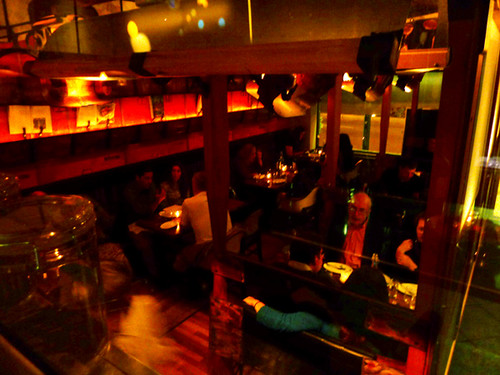
Ruxbin
851 N. Ashland
312.624.8509
Note: BYO; no reservations

1. The second series of my friend David Hammond’s wonderful SoundBites, about the use of sound in cooking, is complete. Unfortunately, WBEZ seems to have lost the page that listed them all, but start here; I especially like the first two, one in the predictably futuristic sound environment of Moto, the other in which Mark Mendez (of Sky Full of Bacon #15) explains how you can tell where a chef is in his life by looking at his menu. (Check out his new gig as the Sun-Times’ Food Detective, too.)
2. I’ve linked Hugh Amano’s Food on the Dole before, and it’s in my blogroll, but it’s worth doing so again for this tribute to line cooks.
3. Emily Nunn has a sweet piece about baking bread for her stepdaughter before she goes away for two weeks. (The stepdaughter, incidentally, is a classmate of my son’s. It took both of us an embarrassingly long time to realize the connection.)
4. Tuscan Foodie announces his intention to rediscover the lost world of the Beefsteak, which was an event, not just a food.
5. I met the couple who do Driftless Appetite, a Wisconsin blog, on my cheese tour, and linked to their posts about that. But I really liked this post about a smoked fish shop near the Mississippi, and can’t wait to check it out sometime.
6. Even better than Halloween cookies, it’s Dio de los Muertos cookies, with cool black and white photos.
7. I wish the image was better, and the sound may or may not work, but this is still really cool: Slow Motion Japanese Food Fight.
Japanese Slow Motion Food Fight – Watch more Funny Videos
Oh, and by the way, here’s me on You Me Them Everybody. He’s a really quick mind, I recommend being on the show just as media training if nothing else. I’m lucky I didn’t say “Heck of a job” like Obama did to Jon Stewart, and there are places where I just stall in mid-air, but parts of it are really funny. I think.

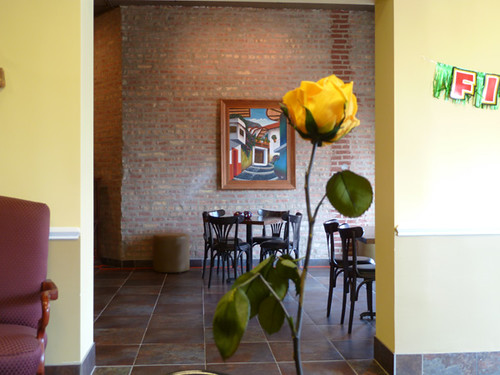
Chantico is an attractive Mexican restaurant a little ways past one of my earlier discoveries, the grocery store and restaurant Ricardo, on Diversey west of Pulaski. The neighborhood is from Jalisco, mostly (the shop names make that fairly obvious), but one of Chantico’s specialties is apparently enchiladas poblano, which is to say, enchiladas in the style of Pueblo. I asked the owner if he was from Pueblo, and the answer I really got was no, he was from long experience in the restaurant biz in Chicago.
Which is a good and a bad thing, when it comes to opening a Mexican restaurant that’s a little nicer than most of the hole-in-the-wall joints around you. The bad part is if you’re tempted to remake Mexican food in a more American dining style. This is the problem I have even with some of our best alumni-of-Bayless places— summed up by the little Chichen-Itza pyramid of rice next to the steak that you often see in upscale Mex. Basically you’ve taken Mexican flavors and used them in an entirely American way of dining, a big piece of protein and a side of rice; it’s the same steak and starch you’d get in a Wisconsin supper club, with a taste of Mexico spooned over the top. Even when Mexicans eat steak and a side of rice, that’s not really how they eat it; it’s essentially an American fusion dish, invented here to match American preconceptions about what makes a $22 entree.
Does that matter? Wouldn’t you rather have a pumpkinseed mole on your steak than A-1 or Heinz? Now we’re getting into the same debate I had with myself over Chizakaya and izakayas. Inauthentic is fine so long as it’s good… but I want to be able to find authentic, too.
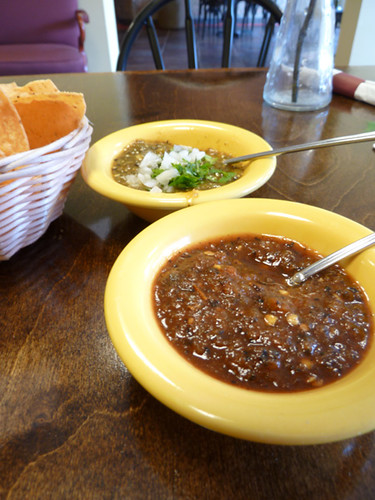
And to get back to Chantico, I liked the authentic things I had here a lot. Starting with the salsas, housemade, with hand-roasted chilis in them. The front one is a smoky arbol, the rear salsa verde, and both pleased me with the full rounded flavor of fresh ingredients, even bringing out a little sweetness as well as considerable heat in the salsa verde.
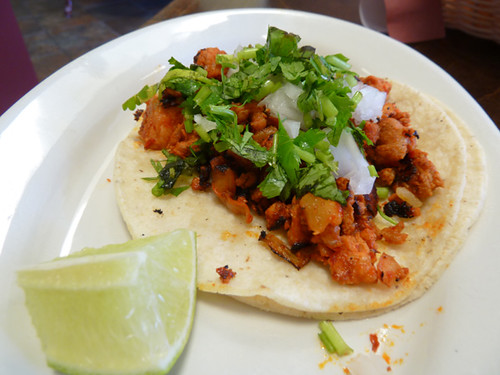
I tried a pork adobado taco, as an appetizer, or maybe a control. I liked it a lot, about as well as any non-spit pastor-type taco I’ve ever had. The adobado didn’t seem to be just out of a Goya can but to have well-rounded flavor, the pork was cooked to order and tender and juicy.
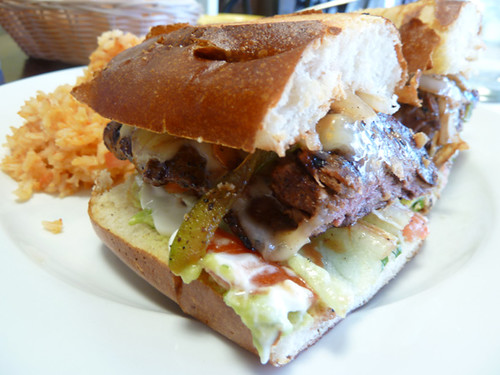
Then there was what was supposed to be a torta. Except it had been changed in all sorts of ways. Instead of a thin slice of tough beef, there was a tender, freshly-grilled to medium piece of thicker steak. Instead of a crispy torta roll, there was a kind of pretzel bun, like on the burger at Kuma’s. Here something that works fine as it is had been Americanized halfway out of recognition. But you know what? Even with the manifest wrongness of the pretzel bun this was a pretty tasty sandwich, and I was happy to find its second half waiting for me in the fridge the next day. It’s just not an authentic one. But when the owner is telling you how it matters to him to use good beef and cook it right, what are you going to do, tell him, no, you should use the cheap gristly stuff everybody else uses and cook it to roofing tile like they do? They didn’t have to close Cemitas Puebla to open Chantico, they both exist in Chicago right now. Good for him for having pride in his quality ingredients.
So Chantico is an attractive place, with a committed owner who could use some business. If you want authenticity, quiz him a little about how things are made before ordering. But I’ll be back for several things on the menu, including the enchiladas poblano and the fish tacos. That’s the kind of thing where I think his pride might make for a particularly strong example of the form.
Chantico Mexican Grill
4457 W. Diversey
(773) 687-8604
* * *
And so I come to the end of my effort to discover 50 restaurants that had never been reviewed on LTHForum, which began over two years ago here. At the time I felt that LTHForum, which I helped found, had grown stale, people eating at the same places over and over again (I joked to a friend about making “LTH Greatest Hits Tour” T-shirts listing dates of revisits to the likes of Lao Sze Chuan, Myron and Phil’s, etc.) I wanted to prove that there was plenty more out there to be found— and I think I did; though many of the places proved to be ordinary, and more than a few have since closed, the list’s discoveries came to include a great middle-eastern place in a whole enclave of middle-eastern food on the south side, a whole genre of supermercado taquerias (I eventually decided not to count them towards the 50, because they’d have been a third of the total list), a music venue hidden in a grocery store, and more. (You can find them all by clicking Restaurant Reviews under Categories, and looking for the reviews with numbers in the titles.)
So what was the point of this exercise? I actually had the discussion about that a few months back on LTHForum itself, when I protested the fact that discussion had shifted so much toward Burger King, Five Guys, Chick-Fil-A and other such fast food things. My point was, we had lowered the barrier to entry too much, if people could participate with nothing more than frickin’ Burger King to offer their fellow foodies; at the very least you should have to talk about your local taqueria or whatever. As I noted a while back, Wendy Aeschlimann summed up my side of the argument admirably:
People can post about anything they want. That said, I find it exceedingly odd that the food that is “capturing the imagination” of this board lately is mass-produced, of inferior quality, involves CAFO meat, “prepared” by a teenager trained by corporate, and available on every toll road. I don’t get it. One of the reasons we all live in a big city is precisely so we don’t have to regularly eat that stuff — much less discuss it.
Frankly, I’m surprised this was even controversial; it wouldn’t have been when LTHForum was started. But this isn’t the first place where mediocrity has snuck in under the guise of “tolerance.” In any case, my 50-unreviewed-restaurants project was mentioned as evidence that all the continents hadn’t been discovered yet; that there were great rewards out there for the adventurous foodie, if only you would get off your butt and look for them.
I still believe that’s true— but I also think something else has shifted in the six years since LTHForum first came along. Part of the reason the core group of us who started LTHForum, or were central to its early growth, got so enthused about cheap ethnic dining was because fine dining, which was all the media talked about then (with a few honorable exceptions— the Reader on occasion, the Cheap Eats column in the Tribune), just didn’t seem that interesting much of the time. We weren’t prejudiced against it per se— I made my name on Chowhound in 2002 with an epic recounting of the 23-course meal at Trio prepared by a promising young chef named Achatz— but we certainly found it far from the only, or even most, exciting thing happening in food locally.
There was one mainstream media review of an upscale restaurant that always stuck in my mind. It was a fake pan-South American joint near Navy Pier called De La Costa, and the reviewer (a big one to this day) was talking about some martini glass containing a few spoonfuls of ceviche… for $50. Which he seemed to think was an okay deal, and I thought was insane. Of course, difference #1 is that he had an expense account for such follies, and I don’t. So right there was a reason why I felt more inclined to trust my fellow LTHers, who would go out and find ceviche for $8.95 in some Latino neighborhood that would blow this stuff away. And that is why LTHForum mattered, because it knew how to respond to a bullshit dish from a bullshit restaurant like that with something practical and good, that made you feel smart for preferring it to what the suckers eating downtown were paying too damn much for.
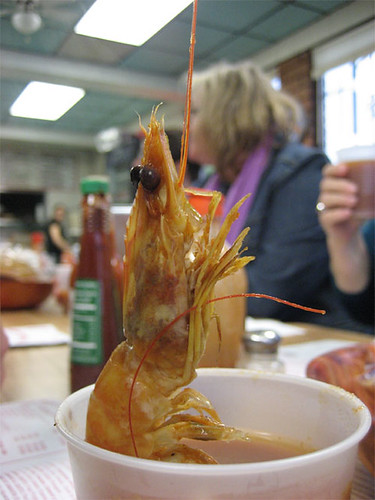
Not a $50 martini glass of ceviche.
The first thing that changed over time was that the media started paying more attention to what we paid attention to (and even sometimes hiring us to cover it). New outlets like Time Out Chicago included the ethnic food/neighborhood scene in their coverage as a matter of course, and the ones that already did cover it did more of it, because we proved there was a receptive audience interested in it. Increasingly when somebody would do a “100 best things we ate” list, it would be spotted with the things we cared about and turned people on to, Burt’s Pizza and Cemitas Puebla and Katy’s Dumplings.
But what also has changed is that dining in Chicago has changed. The use-every-part-of-the-pig, simple-farmer’s-market-tastes ethos that has come to dominate at least the middle of the high end— what David Hammond calls the non-interventionists, as opposed to the molecular gastronomists— has had the effect that fine dining now has a lot more of the virtues that our little ethnic places once had for us. They’re serving food that’s not gussied up and artsy-fartsy, but sings of its authentic flavors and peasanty pleasures. It’s certainly why my blog is about a lot more medium-high-end dining these days than it was even when I started it; that scene’s just a lot more exciting to me than it used to be.
But those places are on the media’s radar in a way that taquerias never were; no LTHer is ever going to discover the next Purple Pig, because the next Purple Pig has a PR person working the media three months before opening. So the discussion on a board like LTH— and the same is true of Yelp, and the blogs, and so on— is never going to lead on those places. That’s why, what LTH is talking about this month, is what was in Time Out last month, or three or six months ago. This still has value— you get a picture of how restaurants evolve, which you don’t from some magazine or newspaper laying down the law on a place once in an official review. But it’s a different thing; it doesn’t have the thrill of uncovering hidden worlds that we once knew when Devon and Chinatown and Maxwell Street first began to divulge their secrets to us, now almost a decade ago.
So I’m done trying to school LTHForum on finding new places. Its job now is real-time vox populi reviewing, hopefully about places more worthy than Chick Fil-A. Me, on some days my goal is to be Jonathan Gold, the guy who knows every taqueria in town; other days, it’s to not worry about being something and to do more, sell more pieces and get wider exposure. (Some of that’s in the works, stay tuned.) But at least I can say, there’s no doubt, the city hasn’t been picked clean yet. I found 50; there has to be yet another one, somewhere near you.
Continued from here.
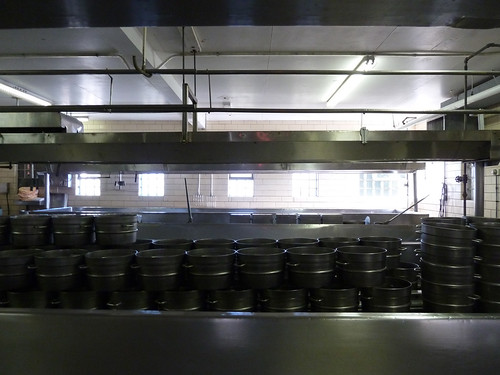
Carr Valley Cheese, LaValle
Carr Valley is apparently actually larger than Roth-Käse or any of the others we visited, but scattered across several plants, so it has the feel of a smaller cheesemaker— at least when you visit its original building, built over the decades around a core that dates back to the early 1900s. Unfortunately, Sid Cook, its master cheesemaker, was out of town and only made an appearance in a video dating back to 1996. But we had a nice tasting of everything from cheese curds to some award-winning washed rind cheeses; I particularly liked the cow-sheep-milk blend Benedictine, a triple cream called Creama Kasa and another called Casa Bolo Mellage.
We did learn one amusing factoid about cheese at Carr Valley: you know why the traditional colors for the wax casing on cheddar are clear or white for mild new cheddar, red for a more aged cheese, and black for sharp, very aged cheddar? Because if they sat around without selling for long enough, red will cover a white wax coating, and black will cover a red one….
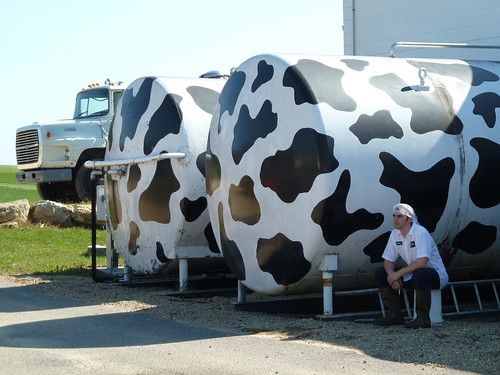

Cedar Grove Cheese, Plain
Cheesemaking was already finished for the morning by the time we made it to Cedar Grove in the town of Plain (a bit redundant as a name for a place in the midwest, it seems to me). And hey, we’d seen cheesemaking already anyway, so owner-cheesemaker Bob Wills took us to see his other pride and joy: an elaborate water purification system which runs the waste water from the cheesemaking process (rich in nutrients, since it started as milk) through a series of tanks where natural processes purify it to the point where it can safely go into the drains. Interestingly, he says not only does it cut the costs of dealing with water on its way out the plant… it seems to have made everyone in his plant think harder about water and use it more carefully and less wastefully, cutting his water bills on the way in, too. And in the summertime, they come out here and snack on the tomatoes and grapes.
Wills is a strong advocate for cooperation between cheesemakers, and often allows other cheesemakers to use his facilities to make cheese and to experiment with new recipes, treating his plant as a kind of entrepreneurial incubator. (He contrasted the Wisconsin cheesemaking attitude with what he saw on a consulting trip to Honduras, where each family cheese plant was protected by armed guards.) He made it clear that letting Willi Lehner, say, work in his facility and observing him at work was as much a benefit for him as it was for Lehner.
We tasted some cheese at his counter— he just grabbed it from the fridge and started cutting it up— but to be honest, by this point I can’t remember what we had, other than a water buffalo mozzarella which he had just made for the first time. (The farm, the only water buffalo herd in Wisconsin, is right across the street.) The texture was too hard, but he admitted he’s working without actually having been to Italy to try authentic examples of the cheese, so keep an eye on this one, it will no doubt get better.
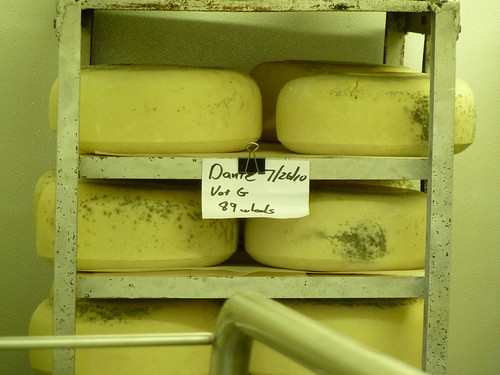
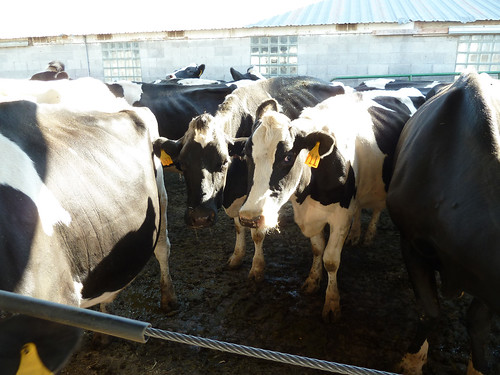
Otter Creek Farm, Avoca
I was especially excited to visit Otter Creek, since I’ve been buying their cheese at the Logan Square Farmer’s Market for some time (and wrote about it here). I didn’t know the half of it. The owner of Otter Creek, Gary Zimmer, is a tireless character preaching his style of farming, which to the extent that I could take it all in a rush of enthusiasm, seems to be organic, rotational farming carried out very intensively to ensure the presence in the soil of all the minerals necessary for health and growth… and involving moving the cattle around a lot so they’re eating the right nutrients at the right time of day and year.

The knock on organic farming is that it doesn’t yield enough to feed the whole world— a comment usually delivered by agribusiness types in a way that insinuates that organic proponents want to cause mass starvation. Yet Zimmer claims that he gets yields from his intensive organic farming that significantly improve on conventional agriculture; and seeing the operation, I’m inclined to believe it, it’s the very opposite of lackadaisical hippie farming. (I was under the impression that the farm was biodynamic, and asked about that— and got a quick response about how waiting for the perfect moon to plant under is no way to get the best yields.)
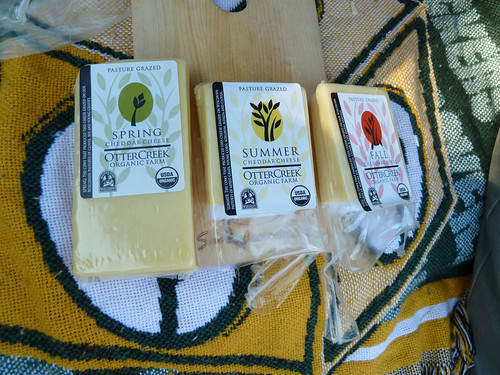
Zimmer’s manager in much of this is his son-in-law, Bartlett Durand, who also has a shop selling local foods nearby, and he treated us to a vertical tasting of their seasonal cheeses, produced from the milk at different times of year, in a tasting room consisting of a Packers blanket thrown in the back of his hatchback. This was the first time I’d tasted more than one side by side and you could definitely taste its evolution— from more floral in spring to more dense-tasting and sharp in fall. We also tasted their spring cheddar studded with ramps, which has a wonderful wild flavor to it quite different from the usual flavored cheese made with supermarket vegetables in it. One especially interesting thing we learned from him: happy cows don’t moo, mooing is basically grumbling. By that measure, Otter Creek is an unusually quiet and contented farm.
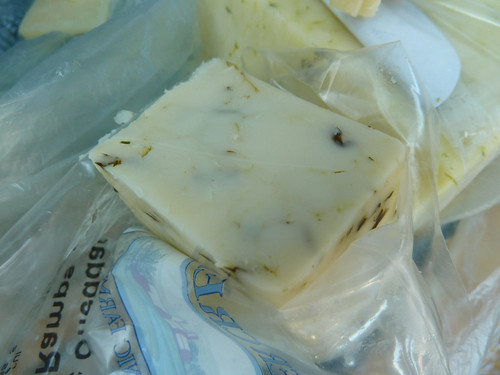
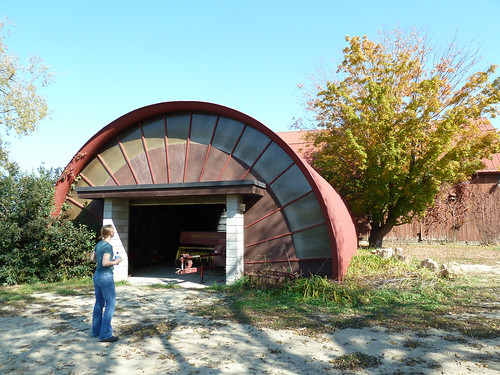
This Otter Creek Farm property (there are several) belonged to one of the architects from Frank Lloyd Wright’s Taliesen. Could you guess from this barn?
The last part of our cheese junket wasn’t another cheesemaker or farm— it was the Dane County Farmer’s Market held each Saturday around the capitol square. I’d always heard it was bigger and better than any of our Chicago markets, much as I love them. But I never realized how much bigger— any one side of the capitol square would make an exceptional market in Chicago, it was the first market that ever exhausted me before I exhausted it. We saw many of the cheesemakers we’d met or tried there, as well as an astounding array of produce vendors, sausage makers, bakers, doughnut makers, everything. It was really a revelation.
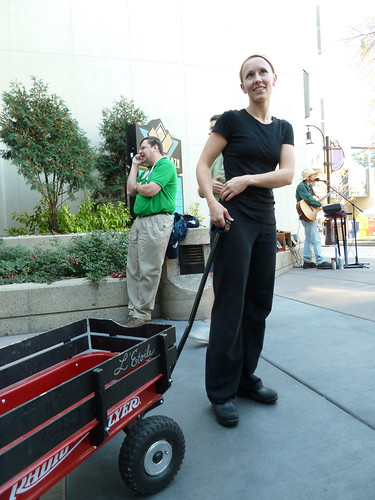
Trisha, a chef in our tour group, worked this day at L’Etoile, proving they really do shop the market as she pulled the official L’Etoile little red wagon.
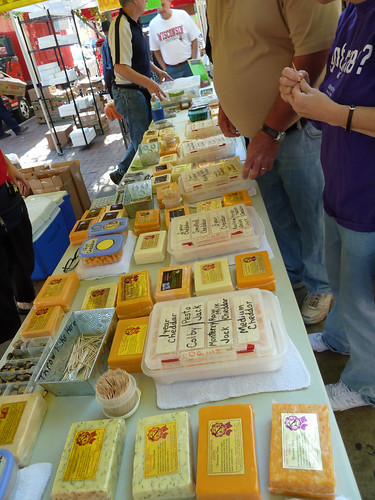
Hook’s table, with easily 30 cheeses to sample.
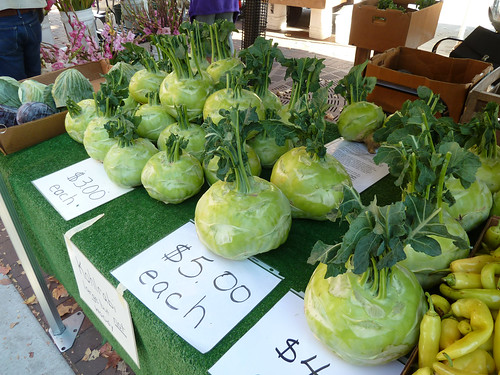
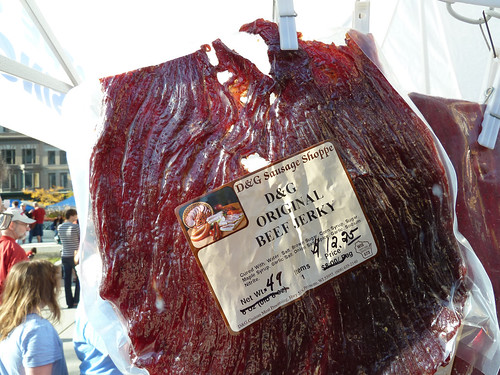
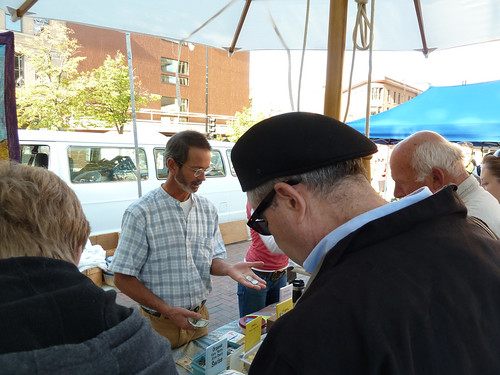
Hammond buys cheese from Willi Lehner.
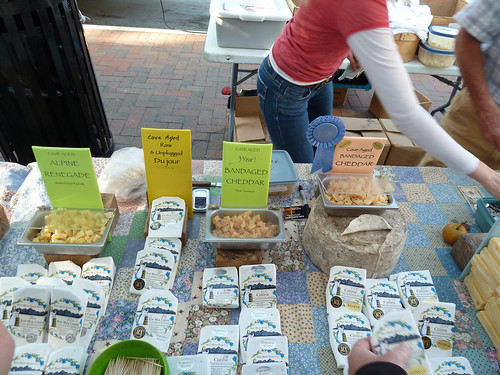
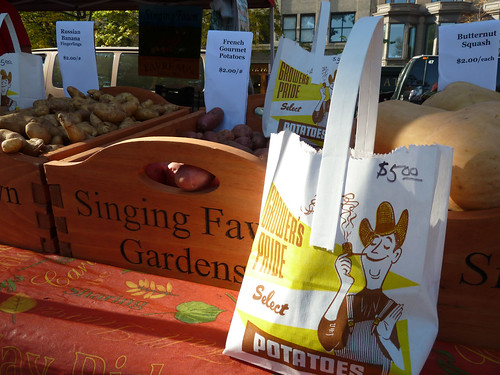
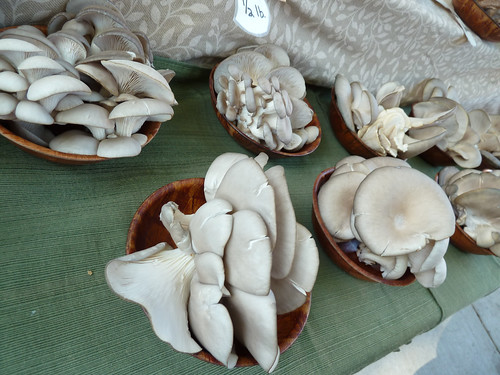
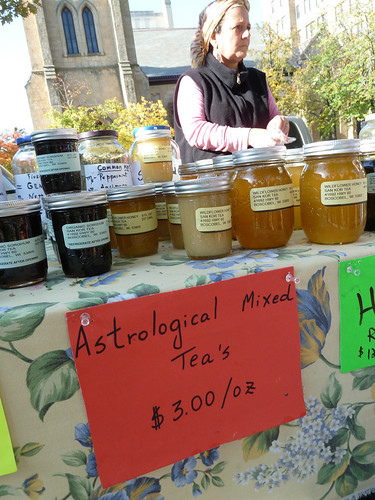

* * *
More posts from other folks on this trip:
Driftless Appetite: The New Rock and Roll
Madame Fromage: Otter Creek
And Cooking With Amy, hilariously, zeroed in on the same monster kohlrabi I did.
I will update this further as I spot stuff…

The cliche, of course, is that urbanites are full of radical ideas and unconventional thinking, while people in rural areas are as complacent as cows. In reality the stereotype more likely runs in the other direction: the societal pressure of city life largely imposes homogenized behavior on us urbanites, but give a man a little land and the freedom to play around on it, and in no time he’ll have built an entirely new way of living powered by cow dung and leftover whey. (You think I exaggerate. Just wait.) I’m always amazed by the practical fecundity of rural entrepreneurs, who sniff out new ideas from farms half a world away and promptly put them to work on their land, over and over. Admittedly, the rural folk I tend to meet are ones who tend to stand out for something interesting they’re up to while raising food, and are surely outliers to some extent, but still, you could drive around for three days meeting cheesemakers and milk producers, and learn something completely new and different at every stop.
Which is exactly what I did last week. David Hammond and I were guests for a 3-1/2 day cheese junket with the Wisconsin Milk Marketing Board, via its PR firm Stephan & Brady, along with about 15 other journalists and bloggers plus a couple of chefs or wine professionals. (Since milk is largely a local product across the country, the growth market for Wisconsin dairy farmers is to have more and more cheese made and exported from the state. So basically the cheesemakers get publicity courtesy of the dairy farmers who want there to be more of them.)
We visited seven cheesemakers within 90 minutes or so of Madison, and though the facilities and processes were largely the same, the approaches were so different and interesting in every case that it never got old, or at least, after starting with the same basic equipment, it soon went off in its own direction reflecting the philosophy of the cheesemaker involved. A good example of how these cheesemakers reflect different philosophies peaceably: at one cheesemaking plant, Cedar Grove, we were treated to a pretty firm attack on the whole raw milk craze by certified Master Cheesemaker Bob Wills, who clearly thinks the sanitation issues (and financial pain of throwing out whole batches that test as contaminated) far outweigh any positive benefits.
At the very next stop, Otter Creek Farm, we… tried raw milk ourselves, fresh from the tank and the cows half an hour before. (No one either died or felt suddenly reinvigorated.) And we were treated to an equally vigorous opposing presentation of the virtues of this most natural of products.
Now, guess who actually makes Otter Creek’s cheeses for them? Bob Wills, at Cedar Grove.
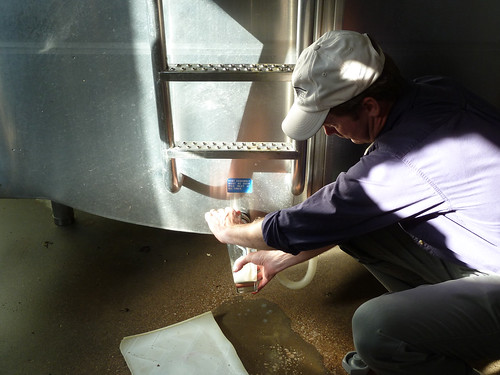
Here and in a followup post will be the seven stops we visited; you wouldn’t be able to just walk in and get the same tour, but nearly all of them have a store which you could visit, which might give you at least a little opportunity to see how it’s made, just a few feet away in many cases. Or you could taste their cheeses via shops such as Pastorale and Provenance in Chicago, or in Madison at the Dane County Farmer’s Market and the cheese shop Fromagination, located on the capitol square.
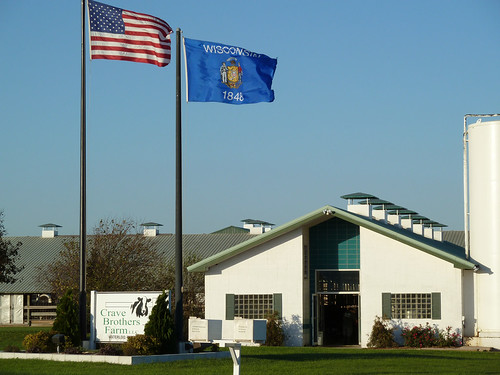
Crave Brothers, Waterloo
Crave Brothers— not a cute foodie name, they really are brothers whose last name is Crave— has a thousand dairy cows at a farm big and industrial enough that we drove our bus through the barn, as if it were Cow Country Safari.

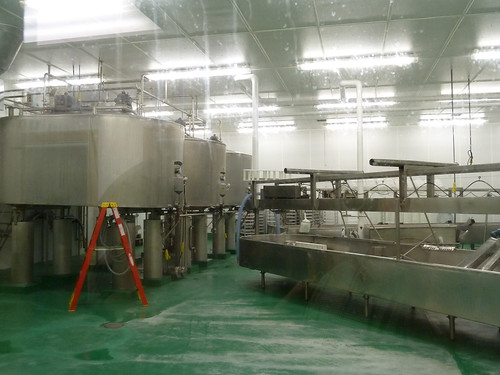
This is a big operation with little of the romantic image of the Old World cheesemaker to it; the endless rows of high-production Holsteins who are milked three times a day (other farms consider two more humane, though the cows may not really mind since they will try, on occasion, to get back in line for another go-round) make that clear enough. And George Crave said that they got into making the cheese they do— mostly fresh mozzarella, including private label for, it was hinted, a certain yuppie grocery chain— purely as a business decision, going to distributors and asking them, what did they want a new supplier for, that would provide the margins the Craves wanted? That said, there’s nothing wrong with well-managed bigness per se, since for one thing it afforded them an opportunity to partner with an energy company on a system that processes the manure the farm produces and burns the methane, producing enough power to run their entire farm and several hundred homes besides. This not only uses that much less of some other power source, but gets rid of the giant-poop-lagoon problem common to large animal operations.
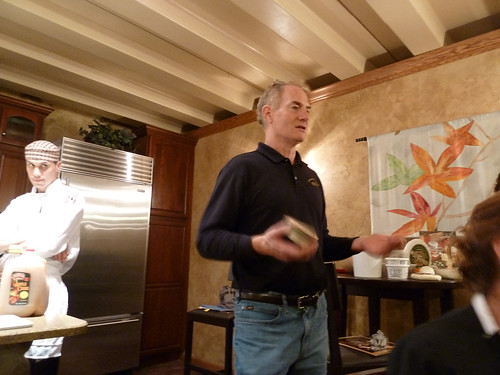
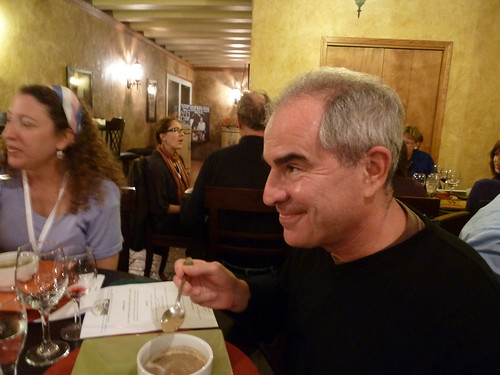
Business is good, clearly, to judge by the winery-like tasting room in which we had dinner. But in time they felt the urge to make something more artisanal like some of their neighbors, and they began working on an authentic Münster-style cheese. What they got, however, was stinkier than they thought the market could bear, and so they went back to work creating what struck me as kind of a deodorized American take on stinky cheese— Les Freres, a soft cheese with a kind of nuttiness and something resembling funk, yet without the foot smell of a truly stinky cheese. That makes it sound like it’s dumbed down, but the combination of this nutty, gently funky cheese baked with wild mushrooms was actually pretty wonderful. Likewise, their mascarpone, put into various desserts, was mild on its own but elevated the sweet flavors with its cheesey tanginess, and made for excellent sorbet and a lemon cream filling, among other things.


Bleu Mont Cheese, Blue Mounds
We got plenty of romance the next morning, starting at Bleu Mont, run by Willi Lehner, famous for his cheese cave— the only “cave” of its kind in Wisconsin which is actually underground. Carved into a hill, it looks like a hobbit house, befitting the somewhat elfin Lehner, a thoughtfully serious man of Swiss parentage whose property is dotted with solar panels, a new wind turbine (the previous one fell in a storm) and other signs of determined self-reliance.
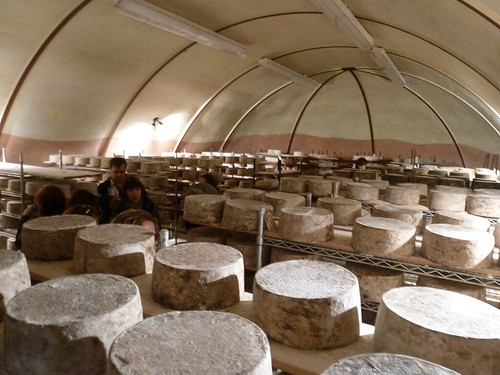
It was in Lehner’s cave that I got my first blast of what I’d come to know as the smell of artisanal cheese: a sort of sweet, Band-Aid crossed with wet plaster scent in the air. Lehner had experimental batches of various things around the edges of his cave, but his main cheeses were two aged raw milk cheeses, one called Alpine Renegade and one a bandaged cheddar, which he sells at various ages at the Dane County Farmer’s Market. I especially loved the latter, hard and tart and concentrated, studded with crystals and with a distinct chalky-cave taste around the outer edge, and bought a chunk from Lehner at the farmer’s market a few days later, which I will nibble at carefully for weeks to come.

Uplands Cheese, Dodgeville
Lehner’s only facility is his cave; he makes his cheeses at other plants such as Cedar Grove, and his milk comes from Uplands, another dairy whose artisanal dedication is obvious (for one thing, from the ribbons and medals on the wall; their signature cheese, Pleasant Ridge Reserve, has won best of show three times at the American Cheese Society, which is twice more than anyone else ever). As a farm they feed their cattle by rotational grazing, which means among other things, that when growing season is over, so is milk production. So we saw them close to the end of their cheesemaking season— not a concept that would have any meaning at a big industrial facility, but plainly essential to their vision of how to make the best cheese.
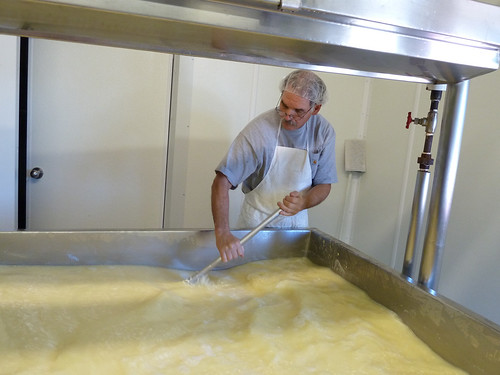
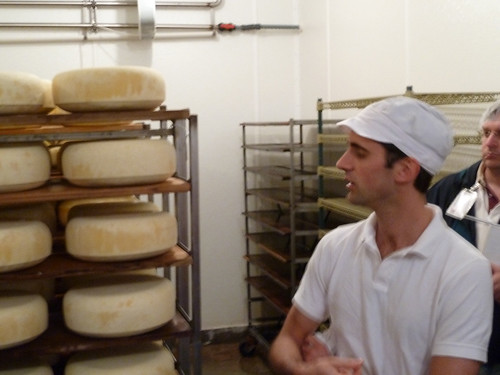
Andy Hatch is Uplands’ current cheesemaker and something of a star (he’s on the cover of the Wisconsin Cheese Originals cheesemaker pinup calendar). (Easy there cheese groupies, his wife was packaging cheese for shipping as we toured the plant.) Because the milk that goes into the cheese changes with the seasons, each week’s batch is carefully watched and tasted individually (via core samples) to decide when it’s ready to be released:
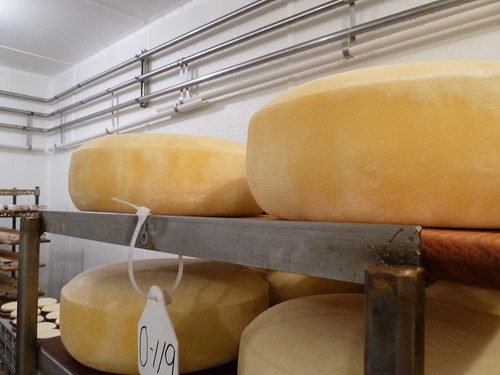
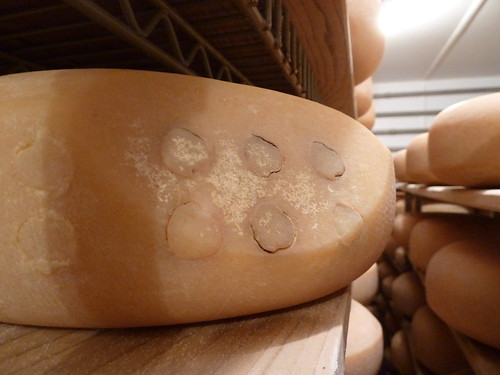
I liked Pleasant Ridge Reserve, but after the Beethoven mouth-blast of Lehner’s bandaged cheddar, its subtlety and undeniable balance seemed admirable but less of a knockout to me. Maybe that’s what the judges in a competition like, though— subtlety.
I was more intrigued, in fact we pretty much all were, by a camembert-looking cheese to be called Rush Creek Reserve which should be available in another month or so. We hinted broadly at our willingness to be early tasters of it, but all we got was stickers— the labels for the packaging, coming shortly.

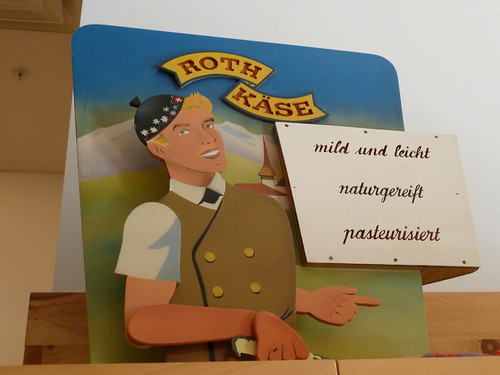
Emmi-Roth-Käse, Monroe
After two examples of artisanal cheesemaking at its most artisanallish, Roth-Käse, a venerable Wisconsin cheese company (founded 1863) recently acquired by the Swiss conglomerate Emmi, was a blast of industrial reality. My first impression— possibly a bit crabby as we were behind schedule for lunch— was that they seemed much more interested in sanitation than, you know, cheese. (To be fair, I think our guide was stalling while waiting for the first half of our group to move on.) But certainly it’s a big, shiny steel cheese plant, proud of its technology (though we never did see the robots who move cheese wheels around in the two-story cave) and dedicated to producing a consistent industrial product.
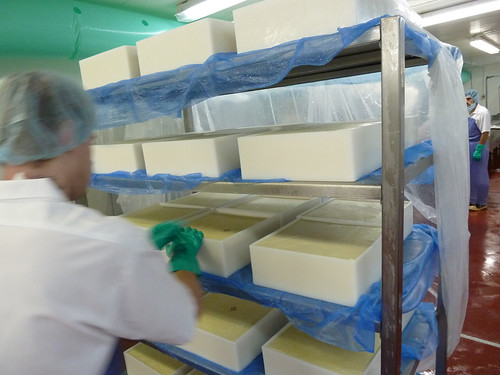
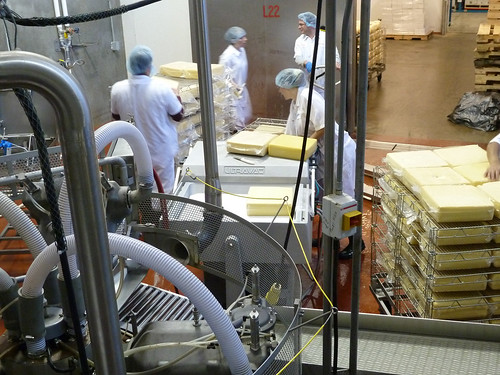
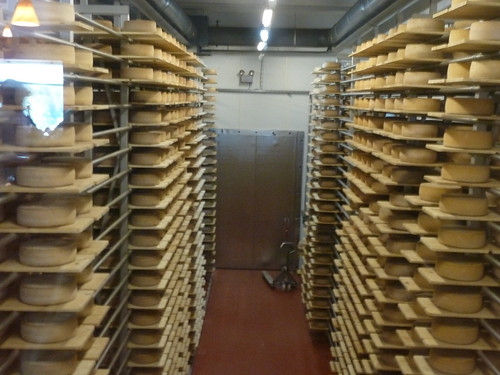
Even so, there was evidence of a human touch here and there. After passing through the various cheesemaking areas, we descended into the hall with the caves, which boomed with echoes of industrial noise and released blasts of steam like the Seventh Circle of Cheese Hell. And there, in the depths, the rinds were washed by hand by an employee who hoisted two of the huge wheels at a time, dropped them on a table with a resounding boom, wiped them with the culture and then dropped them back onto the shelf— all in a flash, and with a kind of brawny Teutonic relish that seemed to have walked out of an Upton Sinclair novel.


And then there was lunch. Our main course was fondue (ah, spared from going to Geja’s for another decade), but before that, we had a tasting of some of Roth-Käse’s cheeses along with a variety of accompaniments— a plate of different foodstuffs, and a series of glasses containing everything from New Glarus beer to a small production kirsch one of the chefs had brought back from a recent Swiss trip. It was fun to try, though I have to admit, I didn’t come to any deeper conclusion about cheese pairings than that just about anything sweet goes well with just about any cheese.

Ironically, the gruyere that is the plant’s main reason for being was not particularly admired, by me or anyone else. But I very much liked Valfino, a soft cheese (at top) which took a first at the American Cheese Society last year, and the horseradish havarti at bottom. Best of all were the two blues— a creamy Buttermilk Blue, top, and Moody Blue, which is very lightly smoked. Both were terrific (and I was happy to note that both are available at Whole Foods).
This gracious lunch concluded with our chef demonstrating another of his skills: yodeling.
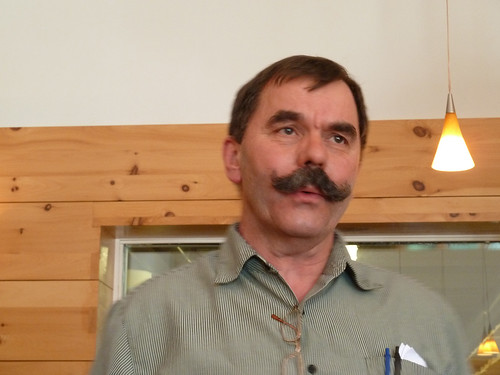
* * *
Here are some links to things others on the trip have written about it:
Hammond on Lehner
Philip Potempa of the Northwest Indiana Times filed daily from the bus while the rest of us goofed around; here he is on Friday and Saturday.
Rustic Kitchen (who promises more to come)
Madame Fromage: Cheese Coma and Notes From a Cheese Media Tour
It’s Not You, It’s Brie: Day One
Sippity Sup: Wisconsin Milk
There will be more of these in the next installment, too, I’m sure…
Okay, so understand that I know no one in Madison, Wisconsin. No one. I was there on a cheesemakers’ junket (fully underwritten by the Wisconsin Milk Marketing Board; consider that disclosure) on Friday, and the first moment I had free to wander the city, I went over to a highly praised cheese shop, Fromagination.
And I immediately saw someone I knew.
In the city where I know no one.
It was Tim Dahl, former pastry chef of Blackbird, who appeared wittingly in Sky Full of Bacon #6 (the second half of the mulefoot pig saga) and unwittingly at the beginning of Sky Full of Bacon #8 (the one about Oriana’s Asian pears, which he had commented on during the mulefoot shoot and used in his dessert). “Tim Dahl!” I said.
He turned to me with the look of a man on the ten-most wanted list who has finally come face to face with the FBI. I reintroduced myself and said I had heard he was opening a restaurant here with his wife, Elizabeth, formerly the very wonderful pastry chef of Boka/Landmark.
“We’re opening tonight. In ten minutes,” he said, sort of shaking like he was attached to an exercise machine. “And— we— don’t— have… cheese!”
I let him get his cheese and wished him luck as he went out the door, vibrating like a tuning fork.

An hour or two later we were being seated in the private room of L’Etoile, just around the corner. L’Etoile has long been Madison’s best and most influential restaurant, to Madison restaurants what Mount Rushmore is to reasons to visit South Dakota. Food media always talks about Alice Waters, because they always talk about people on the coasts and barely know the midwest exists, but Odessa Piper, who started L’Etoile in an old brownstone in 1976, is probably just as important a figure in terms of working as a restaurateur to foster better farmers, cheesemakers, everything from the fertile farmland around her. If she had been in California and Waters in Wisconsin, she’d be the one you’d have heard of.
But if the above photo doesn’t exactly look like a cozy post-hippie university town place in an old brownstone, it’s because Piper sold L’Etoile in 2005 to employee turned current chef Tory Miller and a couple of backers including his sister, and in August it moved to much glitzier surroundings opposite the capitol building. (Madison, like Austin, Texas, manages the neat feat of being both a laidback post-hippie college town and a den of legislative inquity, which if nothing else, seems to be good for the restaurant scene.)
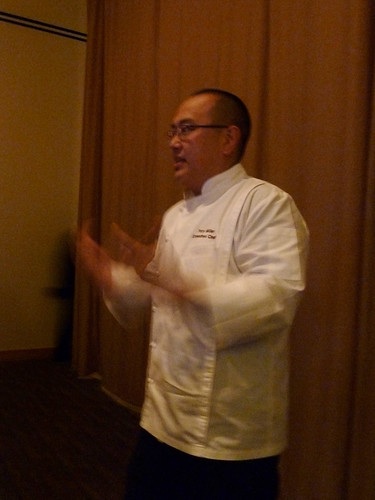
So I knew why L’Etoile mattered to the history of midwestern dining; what I didn’t necessarily know was whether it still did, or whether the many farmer’s-market-shopping chefs and restaurants that had followed it, not only in Madison but all around, had surpassed it. Certainly Miller still talked the talk, since the menu was dotted with the products of artisanal cheesemakers we had met during the trip, and he spoke about his own interest in the cheese scene and a cheesemaker who was our guest at dinner, Brenda Jensen of Hidden Springs Farm, who shared with us one of her newest cheeses, a sheep-cow blend called Meadow Melody.
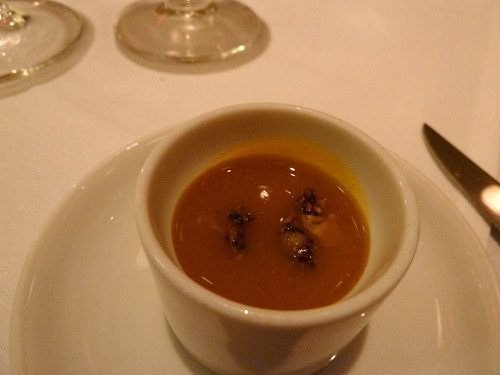
The first bites immediately made it clear that L’Etoile was serious about great farm produce— starting with the butter. How many restaurants make their own butter? Not many outside of Wisconsin, I expect, but if they tried this butter, they would— it was fresh the way buffalo mozzarella made 20 minutes earlier tastes fresh. An amuse-bouche— something like an apple compote, on a housemade pretzel cracker with chives— was like a shot of concentrated apple cider, another— a shooter of butternut squash soup, made with a rosemary-pepita gremolata (I don’t actually know what all the words in that sentence mean) glowed with golden warmth and deep notes of citrus and rosemary. I’m going to try to reverse engineer it this week, and if I make something half as good, it will be one of the best things I make all year.
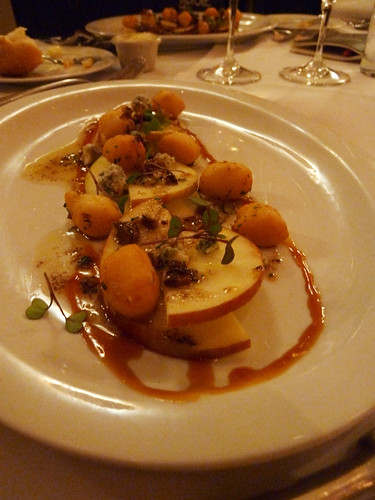
All of which made the next courses a bit confounding. We had two possible first courses on our preset menu; one was deep-fried gnocchi made with goat’s cheese, apples, bits of buttermilk blue cheese and a sage-brown butter/apple cider reduction sauce. I liked many parts of this— the twin sauces were wonderful, the gnocchi were light and airy— but I wasn’t convinced that they belonged together; a big sweet crunch of apple or the creamy sharpness of blue cheese easily steamrollered the ethereal gnocchi in the mouth. The other was Tuscan bread soup with housemade pork meatballs. The waiter had raved about the broth’s complexity, but what I tasted seemed far too Kellerized, an obsessively thin and clear broth where cloudy, rough-edged robustness would have served the classic dish better. What more than saved this dish, and again reminded you of how skilled the restaurant could be with good ingredients, were the marvelous pork meatballs, which brought funk to this dainty broth like George Clinton at a debutantes’ ball.
If I ever do a Mike G’s Rules #2, one of them will be: Don’t Order Steak In a Chef-Driven Restaurant, It Will Be the Most Boring Dish on the Menu. But I was lured in by extravagant claims made for the beef from this particular farm, and you know what? Yeah, it was good beef, a nice mineral tang, but loaded mashed potatoes, a cabernet jus and some broccoli still made for a dish as safe as a bank vault. Far better was a rainbow trout, served on a sweet potato puree, bits of smoked ham and a bourbon-based sauce— with onion rings. Crispy, hearty yet delicate, a dish that revealed new sides of itself as it danced in your mouth, this was the entree that proved that Miller could make not only good parts but good entire dishes.
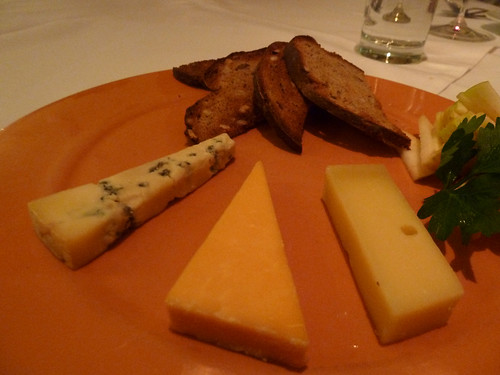
A cheese course followed, not exactly surprisingly, giving us a chance to taste the most rarefied products of several we didn’t visit. Dunbarton Blue— the same cheese Tim Dahl had been buying earlier that day— is a beautifully balanced blue, though a couple of days later at the farmer’s market, I wound up preferring and taking home a different one; Hook’s 15-year cheddar is concentrated cheese pucker, almost mushy in texture but profoundly sharp; Edelweiss Emmentaler, likewise, tastes like concentrated essence of Swiss, while Marieke gouda, perhaps my favorite of the group, has an almost liqueur-like rounded flavor.
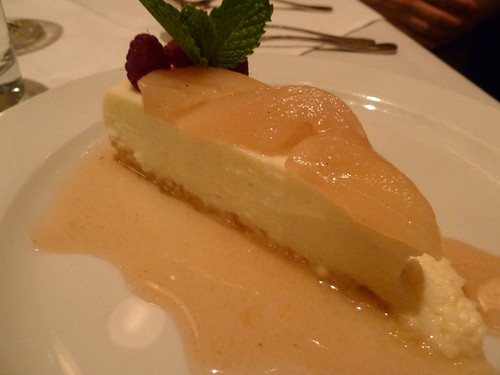
And then there was dessert, and again the hit was so glorious that it made the miss seem small, but also, that much more confounding. Caramelized apples with Hook’s 15-year cheddar and a green apple sorbet were wonderful, essence of fall’s tartness and comfort, so why were they saddled with being plopped on a dry oat streusel that had the consistency of a gravel driveway? It was like a vegan restaurant’s whole-grain-hairshirt idea of dessert. Yet a cheesecake made with Fantome Farm chevre was exquisite, weep-worthy, light as marshmallow fluff yet with the intellectual rigor of goat cheese, and set off by the lightest touch of fruit— tender vanilla-poached pears, a nectar-like peach sauce. The best cheesecake I’ve ever had? One of the best desserts I’ve had in the past two decades? Yes, yes, amazing.
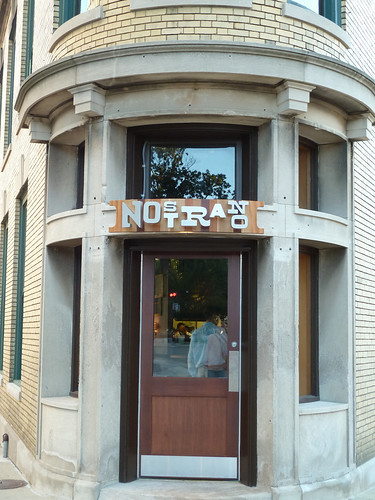
We couldn’t have eaten another bite if we’d wanted to, but having shared my story from earlier in the day at dinner, a small group of us decided to go over to Tim and Elizabeth Dahl’s restaurant just off the capitol square, called Nostrano (which means something like, simply, “Ours”) and have a drink and see how the first night had gone. The chef himself was in a decidedly mellower mood, exhausted but clearly happy with his first night, at which they’d served some 80 people over the course of the evening (capacity at one time being about 50) without blowing up or falling apart.
We asked Dahl about the direction of the menu. It’s Italian-ish, and hugely driven by the farmer’s markets, which, he said, happen nearly every day in the vicinity, beyond the Wednesday and Saturday schedule of the main market literally right outside their door. Charcuterie is a big part of the menu— he said that all his cooks were eager to make a bunch of different kinds, and he’d had to limit them to one each right now, they can make something new next week— and so is a cocktail program a la The Violet Hour, complete with mixologists in Violet-like vests, housemade bitters and the like. What struck me the most was how restless Dahl seemed to be, not only talking about how he got tired of making some of the signature desserts for Blackbird and Avec over and over but how he wanted to change the menu at Nostrano week after week, to be producing new things all the time. Some of that is simply pent-up energy— Dahl had been a generalist before joining Blackbird as a pastry chef because that’s the position that was open— but some of it, too, must be someone just itching to make things with all the great stuff he sees being sold by farmers around him.
So compared to L’Etoile’s glitz and Keller-broth-meets-Batali-meatballs contemporary vibe, Nostrano looks like a dose of specifically Chicago-style porky comfort, Italian simplicity and cocktail renaisssance. But it’s also rooted in the farm to chef connections made in Madison by L’Etoile, and while that restaurant morphs into something bigger that’s as much Santa Monica as Madison, Nostrano means there’s still a comfortable little place in an old brownstone in Madison, where they make wonders out of the stuff farmers and cheesemakers truck into town every week.
L’Etoile
1 S. Pinckney St.
Madison, WI
608-251-0500
www.letoile-restaurant.com
Nostrano
111 S, Hamilton St.
Madison, WI
608-395-3295
www.nostranomadison.com

I can’t think of a hot trendy restaurant-of-the-minute opening that has produced more wildly divergent views than Chizakaya, the new izakaya-style quasi-Japanese place which I wrote about a couple of weeks ago. The official review-reviews are still pending, but first people on LTHForum went gaga for it, then I and some others went and were much more mixed in our appraisal, then another critic said he felt I was if anything too kind, but then Kevin Pang went and tweeted rapturously about much of it. With each of these appraisals I’ve questioned my own views— was I too harsh? Was I too easily gulled by good company and not wanting to be the one at the table who said “watta loada crap?” Or am I just being too cynical now and missing its fine and true virtues? What do I think I thought, really?
One of the questions for me, certainly, was how seriously to take the izakaya-ness of Chizakaya— and some of that, from me or somebody, has apparently gotten back to the folks at Chizakaya, who have tweeted on that subject a bit defensively:
My intention was not to take an izakaya from Japan, cut it out and place it in Chicago.
Just because you have had a hot dog in NYC doesn’t mean you can come to Chicago and say our hot dogs are different and wrong.
That goes with us here. Its not what you think when you think of a pub? This isn’t an authentic izakaya? WOW. Pubs vary around the world.
Fair enough. My conclusion really boiled down less to wishing that Chizakaya was an authentic izakaya, than to wishing there was one, somewhere in Chicago. The idea behind Chizakaya— an American pub with a Japanese slant— is reasonable enough. It could result in a “Japanese” place the way, say, Mado is an Italian restaurant— it’s not an Italian restaurant in the normal meaning of the phrase, but in other ways it’s the most Italian of restaurants, because everything it does is influenced by Italian ways of thinking about food.
But by that comparison Chizakaya’s record was decidedly more mixed (of course, so was Mado’s two months after it opened). Some things took that Japanese influence and really ran with it in novel ways— like the hamachi sashimi with bone marrow, which made every fussed-over bite of sushi at the late Kaze seem punk. Others could have been served at any of our new meat-centric joints, but were very good in themselves, like the beef cheek skewers; and others would have been more at home at Fun-On-A-Stick in the Towne Pointe Ridge Mall. (I feel basically ashamed about paying even $3 for the bits of chicken skin on a stick; it’s like paying a dollar to be allowed to lick a Popsicle wrapper. Ironically, grilled chicken skin is actually one of the most typical izakaya dishes on the menu; but there’s something especially preposterous about the tweezer-sized bits of skin threaded onto a skewer at Chizakaya.) Generally, the stronger the Japanese influence got, the more interesting dinner was, so I hope Chizakaya continues to move in that direction— not of becoming more authentic in a rigid sense, but of delving deeper into the culture as it riffs on the idea of a Japanese izakaya.
Which still leaves me wanting an authentic izakaya, somewhere, though.
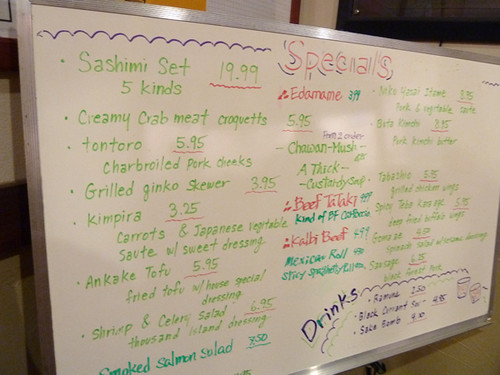
Fortunately a few have existed all along, if not in the city proper, out in the northwestern suburbs where there’s a concentration of Japanese companies and, of course, the area’s largest Japanese market, Mitsuwa. One of them, in a strip mall in Mount Prospect, is called Sankyu, which (in the evening’s only note of hipster irony) appears to come from the way Japanese say the English phrase “thank you.” Unlike the chic Chizikaya, Sankyu has a slightly worn family restaurant feel (at least on a quiet Thursday), not unlike some other homey Japanese spots I like such as Sunshine Cafe or Renga-Tei. Sitting cross-legged at the traditional floor tables knocking back sake, we felt straight out of an Ozu movie, and that feeling was only enhanced by the two women who were our servers, kicking off their clogs each time they knelt down at our table to serve us, endearingly clumsy in their use of English… what businessman could resist a warm, increasingly boozy evening in their sweetly welcoming and forgiving presence?
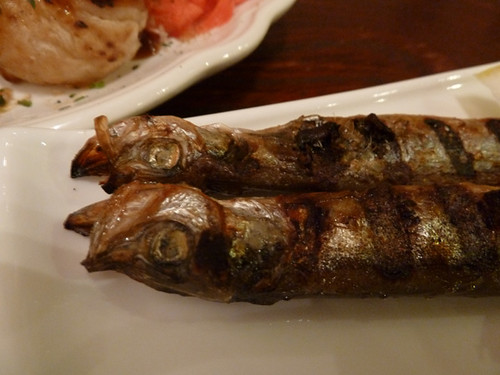
The only noteworthy mentions I’d found of Sankyu on LTHForum were from 2006, at which time the specials board was entirely in Japanese; now not only is it in English, but with internet-era user-friendliness, the paper copy in the menu actually marks some favorite dishes with a smiley icon. Many things were familiar enough from other Japanese restaurants to not seem specific to izakayas— agedashi tofu, goma-ae, etc.— but we managed to put together a group of dishes that seemed to fit the goes-with-a-lot-of-drinking, food on a stick profile. There were grilled whole smelt stuffed with their own roe, which you ate head to toe, and some little fried puffballs with octopus inside— Octodonut!— in a sticky puddle which screamed “supermarket steak sauce” as its main ingredient. When I ordered gingko skewers, our waitress raised an eyebrow and asked “You like gingko?” I said I had no idea, but for $3.95, how could I not order them, whatever they were?
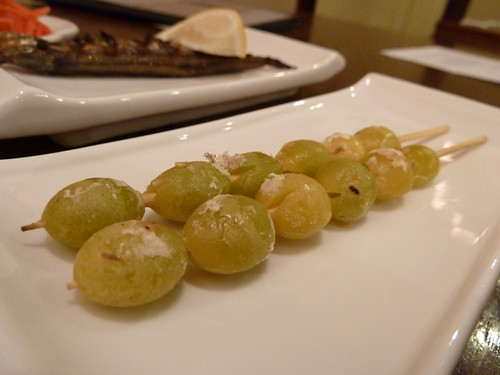
I guess they were seeds, some sort of starchy globe, somewhere in flavor and texture between a lima bean and a bath bead.
Of course, there was meat. I ordered pork cheek, thinking it would be like the beef cheek at Chizakaya, though instead of tender braised meat it was flavorful, chewy grilled meat:
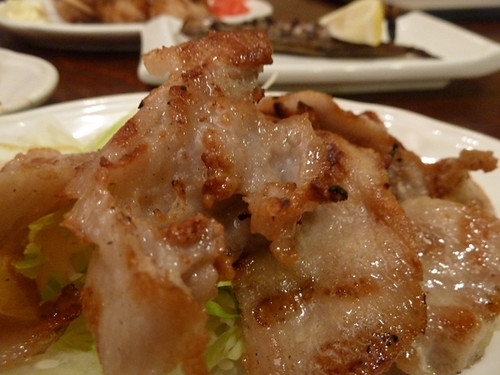
More tender meat came in the form of something described as pork cube, which turned out to be an unctuous hunk of pork braised in a sweet sauce, soft enough to pick apart with chopsticks (mostly).
As with the gingko, though, we were trying to go beyond the easily accessible things on the menu and order anything that seemed really unusual. One of the more surprising things on the menu— and probably a clue to Korean ownership, as is often the case with Japanese restaurants in Chicago— was something called “Pork Kimchi.” That in itself might not seem so odd— bits of sliced pork tossed in with kimchi. What was odd was the actual flavor of the kimchi, which wasn’t the usual red-hot sriracha-type sauce but a mysteriously funky, almost cheesy flavor. Cheesy as in, processed cheese food, a fake cheese taste. My dining companion and I both had to taste it and think about it for a moment, reach the point where we were sure we weren’t just imagining the flavor of, say, a Jeno’s Pizza Roll . But there it was, unmistakably and for real: kimchi with the taste of a boxed pizza-making kit from the 1960s. (NOTE: see explanation in comments. Evidently I need to eat more kimchi.)
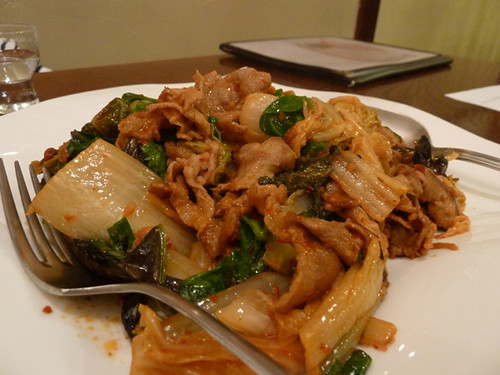
Another strange taste experience came when we ordered deep-fried garlic. It came as a plate of little fried balls of irregular shape, a pile of them you could easily have believed was the testicles of some smaller animal. Our concern, of course, was that the deep-frying would hardly be enough to mellow the bite of raw garlic; so it was quite a surprise when they arrived so mellow that you hardly would have known they were garlic at all. Could deep-frying have taken the bite out of garlic that quickly? Even slow-roasted garlic seems to have more of a garlic sharpness left in it than these did. I wonder if they are some type of garlic known for, well, hardly tasting like garlic at all.
I suppose a comparison like this will inevitably lead to the question, so which is better, Hipsterkaya in the city, or Realzakaya in the burbs? The reality is, they’re too different to logically pair off, and who really needs to make an either-or choice, anyway? You know whether you want an urban hip meal in a new place, or a homey slice of authenticity on an otherwise bland suburban strip. Chizakaya’s chef comes from L2O and there’s obviously greater care and skill in the composition and execution of its dishes— sometimes to the point of preciousness, but certainly of a consistently haute-chichi level. Where Sankyu comes off about at the executional level of a good diner, as well as the portion sizes (and Chizakaya could have used a big hearty plate like, say, the pork kimchi, to avoid sending us out not-quite-full). Atmosphere is quite different and depends on what you want on a given night; price— well, three of us were not quite satiated for about $55 each at Chizakaya, and two of us were plenty full for $45 each at Sankyu.
The real difference for me came with one dish toward the end. In my writeup I described my vague disappointment that Chizakaya, good as it was here and there, hadn’t expanded my mind:
I had something else in my head, a place where deep-fried lotus root or pickled plums or such unexpected, alien-looking things would challenge me during my meal. And I’m still kind of eager to go eat at that place.
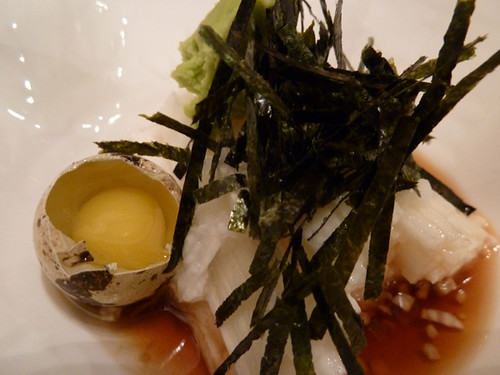
One of the last things we ordered probably should have been one of the first; it was the kind of palate cleanser-slash-eye-opener that would have set the stage for the meal. It was some kind of Japanese yam, cut into toothpicks— starchy, crunchy, like jicama. There was a sauce at the bottom of the bowl that looked like soy sauce but was brinier, almost tart, bracing [NOTE: see comments; it’s ponzu]; there was a quail egg, there was nori, there was some wasabi. And when you grabbed a bunch of the toothpicks with your chopsticks, it came up with a kind of alien-sliminess, leaving curving trails of slimy goo that stretched from the bowl, longer and longer until your mouth finally broke them and they sprang back. Hardly an appetizing thing to look at— and yet when you popped it in your mouth, the crunch, the briny sauce, the creaminess of the egg, the burn of the wasabi all combined to startle and then to amaze, to adjust your preconceptions about what food is. This was nothing like anything we eat in the west, it would surely turn off most people in five different ways, and yet my dining companion and I were both entranced by it, by its utter differentness and yet by its obvious success as a well-thought-out combination with, no doubt, centuries behind it.
Here was what I had come to the izakaya for: a meal of comfort food that, along the way, just happened to expand my universe and blow my mind.
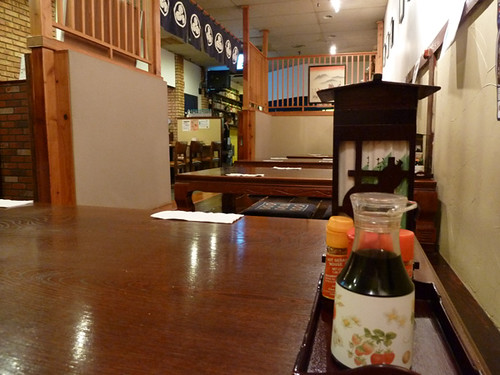
Sankyu
1176 South Elmhurst Road
Mt. Prospect, IL 60056
(847) 228-5539
* * *
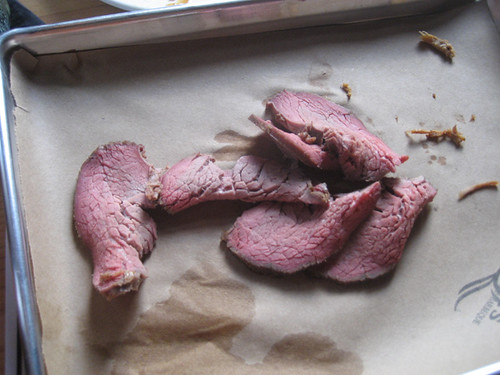
Sankyu having been the last meal of the quarter, it’s time for another list of the best things I ate in the last three months, which will then go into the semi-finals for my ten best list at the end of the year (previous quarterly lists here and here):
• Headcheese with chow-chow, Big Jones
• Tri-tip at Lillie’s Q preview event (photo above)
• Old Town Social’s cheese dog, MK’s snow cone, Green City Market BBQ
• Adam Seger’s Hum cocktail with lavender-jasmine tea, Reader party
• Pho at Pho 888
• Tete de Cochon, Longman & Eagle
• Doro Wat, Queen Makeda, Washington, D.C.
• Sliced pork and hush puppies, A&M Grill, Mebane NC
• This corn soup made with farmer’s market corn by me, about 10 times this summer
• Blueberry mint sorbet, Black Dog Gelato
• Beef shawerma sandwich, Taza Bakery (3100 W. Devon)
• Beef cheek skewer and hamachi with bone marrow, Chizakaya
• Three Little Pigs sandwich at Silver Palm, of which I tweeted: “Always looked like stupid excess. Actually very well made excess.”
• Peach blush (raspberry) jam made by Cathy Lambrecht and myself
• Pork skewers with fish sauce-palm sugar marinade winged by me when I couldn’t find all the ingredients in David Thompson’s recipe
• Panzerotti, pane panella, and tiramisu at Taste of Melrose (watch the video already!)
• That Japanese yam dish at Sankyu (see post above)
Go behind the scenes of one of the midwest’s liveliest and tastiest ethnic food festivals.
Melrose Park, Illinois has been a traditionally Italian-American suburb since the end of World War II, and though it’s starting to change, every year the old neighborhood gets back together for the Labor Day weekend festival Taste of Melrose Park. My friend David Hammond has covered this festival, with some 70 mostly amateur, mostly Italian-American vendors serving up family recipes for three days straight, for several years, so he was a natural guide for this journey behind the scenes. Every dish here has a story about the family who makes it, and we talk to ten of those families about their recipe and why it’s important to them to share it with others. It runs about 19 minutes, but it’s a party, so you won’t notice the time!
Here’s my post about my first visit to the Taste of Melrose Park last year. Here’s David’s very first LTHForum post about it, a post about this year, a Tribune piece, and a WBEZ radio piece about it.
Alternate ways of viewing this video: see it or subscribe to Sky Full of Bacon at iTunes here, or view it at Vimeo here. There is also a family-friendly version (which deletes one off-color bit of humor) here, for institutional or other use. To embed either version, go to that Vimeo page and click on the Embed button to acquire the code to place on your own site or blog.
To see previous Sky Full of Bacon videos, click here.
* * *
Come See Me Do a Talk Show in a Bar!
I’ll be a guest on You Me Them Everybody, taped for audio podcast at The Hungry Brain, 2319 W. Belmont, Monday night at 9 pm., Oct. 4. And I’ll be giving out weird foods to try. Be there!
